
BRITISH CHALK OPHIUROIDS
(Brittle Stars)
Though superficially similar to Asteroids (Starfish), the Ophiuroids (Brittle Stars) form a distinctly separate group within the Echinoderms (modern example). Their characteristic elongate arms are composed of a central column of articulating vertebrae, enclosed within a series of plates. Typically there are four rows of plates; a row of lateral plates on each side of the arm, and a ventral and dorsal row on the under and upper surface respectively. The main body is a distinct disc, with the jaws on the ventral / oral / under surface. Complete individuals are exceptionally scarce within the Chalk, but isolated arm fragments are not too uncommon. A number of species have been described, and a selection of typical specimens are shown below.

1). Ophiotitanos tenuis, ventral (underside) view of a near perfect individual with a fragment of a larger individual, x2.2 (Grey Chalk, Folkestone, from the Willett Collection, Booth Museum, BMB 007838, by kind permission of John Cooper).
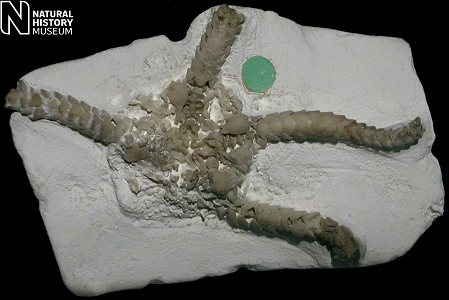
2). Ophiotitanos serrata, ventral view of a very well preserved individual, x2.6 (White Chalk, Dixon Collection, BMNH (British Museum (Natural History) London) E5043. Image © 2005 The Natural History Museum, by kind permission).
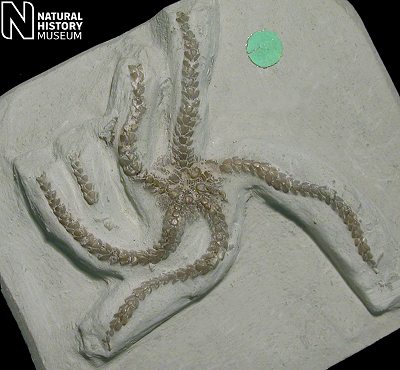
3). Ophiotitanos tenuis, ventral view of a near perfect individual, x2.5 (Grey Chalk, Folkestone, Capron Collection, BMNH (British Museum (Natural History) London) E5057. Image © 2005 The Natural History Museum, by kind permission.
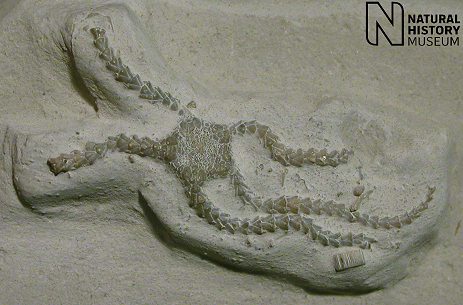
4). Ophiotitanos tenuis, dorsal (upper) surface of a small individual, x4.2 (Grey Chalk, Folkestone, Capron Collection, BMNH (British Museum (Natural History) London) E50576. Image © 2005 The Natural History Museum, by kind permission.
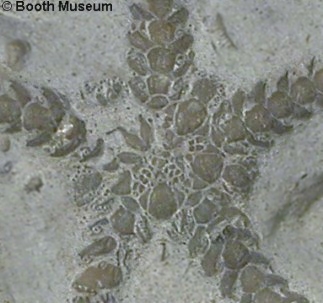 A
A
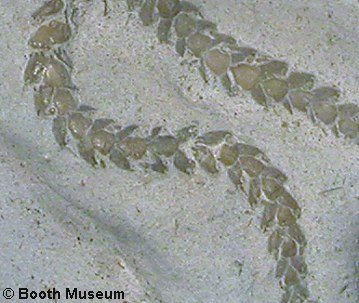 B
B
5). Ophiotitanos tenuis, details of the specimen in Fig. 1; (A) oral surface of the disc, x6.0, (B) ventral (undersurface) of the arms, x5.7.

6). Ophiotitanos serrata, large specimen from the Chalk of Bromley, Kent (x2.0, BMNH (British Museum (Natural History) London) E5052). Image © 2005 The Natural History Museum, by kind permission.

7). Ophiotitanos serrata, detail of the large specimen in Fig. 6 (Bromley, Kent, x2.0, BMNH (British Museum (Natural History) London) E5052). Image © 2005 The Natural History Museum, by kind permission.
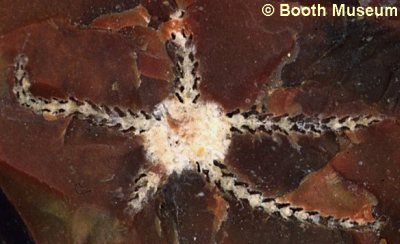 A
A
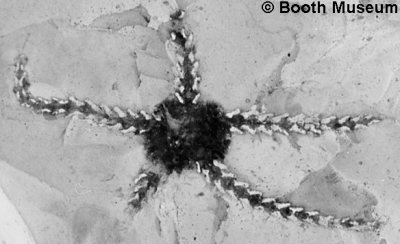 B
B
8). Ophiotitanos sp.?, small but perfectly articulated individual preserved in flint, x11.0, (A) true colour view, the majority of the internal structure has been lost due to recrystalisation, (B) negative view, the lateral plates of the arms can be clearly seen (White Chalk, Booth Museum, by kind permission of John Cooper).
|
|
|
9). (A) Ophiomusium sp., very well preserved individual (x3.5, flint mould, White Chalk, loose gravel, Stokes Bay, Gosport, Hampshire, HCCMS (Hampshire County Council Museum's Service) collection, stored at Gosport Museum, GOS1984.127, by kind permission of Dave Kemp, HCCMS). (B) Ophiura tenuis, partial disc and arms (x8.3, Grey Chalk, west of Cow Gap, near Eastbourne, Randell Collection, RR0444).

10). Ophiomusium cf. granulosus, isolated arm. Note the beaded form of the proximal arm and the imbricated plate-like form of the distal arm (x5.5, White Chalk, Plenus Marls, south of Dover, Kent, in the collection of Keith Little). Image © 2011 Keith Little, by kind permission.
 A A |
|
 B B |
11). Ophiotitanos serrata, arm fragment, (A) ventral surface, x7.2, (B) lateral (side) view, the marginal notches in the lateral plates bore spines in life, x7.2, (C) section showing the internal structure of the arm, a central vertebra is surrounded by plates, the sockets in the vertebra are for articulation with adjoining vertebra, x16 (White Chalk, Sussex?, Randell Collection, RR1541).
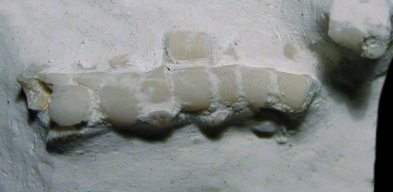 A
A
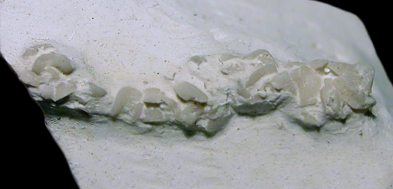 B
B
12). Arm fragments in differing states of decay, (A) Ophiotitanos serrata, (x11.0, Peacehaven, Newhaven Chalk Formation), (B) Ophiotitanos sp.?, (x9.2, Bastion Steps, near Peacehaven, Newhaven Chalk Formation). Both Randell Collection, (A) RR1537 (B) RR1606.
| References |
RASMUSSEN, H.W. 1950. Cretaceous Asteroidea and Ophiuroidea with special reference to the species found in Denmark. Danmarks Geologiske Undersøgelse, 77, 1-134.
SLADEN, W.P., and SPENCER, W.K. 1891-1908. A monograph of the British fossil Echinodermata from the Cretaceous Formations, Vol. II, the Asteroidea and Ophiuroidea. Palaeontographical Society.
WRIGHT, C. W., and SMITH, A. B. 2002. Echinoderms, in: Fossils of the Chalk (2nd Edition), Smith A. B. & Batten D.J. (Ed.s), Palaeontological Field Guide to Fossils, No. 2 , Palaeontological Association, London.